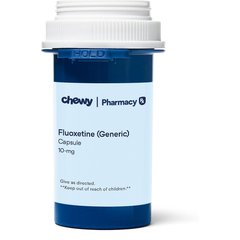Fluoxetine (Prozac®, Reconcile®) for Dogs
iStock/Halfpoint
PetMD’s medications content was written and reviewed by veterinary professionals to answer your most common questions about how medications function, their side effects, and what species they are prescribed for. This content shouldn’t take the place of advice by your vet.
What Is Fluoxetine for Dogs?
Fluoxetine is the active ingredient in the human medication Prozac® and the canine medication Reconcile®. Fluoxetine is used in animals as a behavior-modifying medication and is commonly prescribed to treat separation anxiety in dogs.
It is important to note that all behavior-modifying medications are typically best utilized in combination with a behavior modification plan. This can be achieved in partnership with a veterinarian or certified trainer.
Fluoxetine chewable tablets (brand name Reconcile®) is FDA-approved for use in dogs to treat separation anxiety, in conjunction with behavioral modification, but Reconcile® and generic fluoxetine are also commonly prescribed off-label to treat other behavioral disorders such as anxiety and obsessive-compulsive behaviors in dogs.
This is called extra-label or off-label use because this use isn’t described on the drug label. Fluoxetine is also prescribed off-label in cats for inappropriate urination and separation anxiety.
Fluoxetine is readily utilized in the veterinary field, and veterinarians can legally prescribe certain human drugs, like fluoxetine, in animals in certain circumstances. Your veterinarian will determine which dose and route of administration is right for your pet. Never give your pet a human medication unless prescribed by your veterinarian.
In certain circumstances, your vet may recommend a compounded formulation of fluoxetine. Compounded medications are prescribed if there’s a specific reason your pet’s health can’t be managed by an FDA-approved drug, such as if your pet has trouble taking pills in capsule form, the dosage strength is not commercially available, or the pet is allergic to an ingredient in the FDA-approved medication.
Compounded medications are not FDA-approved. They are created by either a veterinarian or a licensed pharmacist on an individual basis to best suit a patient’s particular needs. You can learn more about compounded medications here.
How Fluoxetine Works in Dogs
Fluoxetine is a selective serotonin reuptake inhibitor (SSRI). Serotonin is a neurotransmitter, a chemical in the brain that sends messages throughout the nervous system.
Serotonin is responsible for moderating mood and behavior, and low levels are thought to contribute to stress and anxiety. SSRIs such as fluoxetine block serotonin from being absorbed back into the nervous system. This increases the amount of serotonin between the nerves and helps the brain regulate mood and behavior.
Fluoxetine Considerations in Dogs
Fluoxetine may increase your pet’s risk of seizures. Tell your veterinarian if your pet has a history of epilepsy or seizures, if your pet is hypersensitive to fluoxetine, or if your pet is also taking other medications, such as acepromazine or chlorpromazine, which can increase the likelihood of a seizure.
It is important to discuss your pet’s medications, including vitamins and supplements, and medical conditions with your veterinarian.
Studies had not been performed to evaluate the safety and effectiveness of fluoxetine in breeding, pregnant, or nursing animals and animals less than 6 months of age at the time of this publication.
Fluoxetine Directions for Dogs
Follow the directions on the drug label or as provided by your veterinarian.
Your veterinarian may give instructions to administer this medication by mouth once or twice daily, with once daily being most common. It can take up to four to eight weeks for full effect to be observed. If your veterinarian decides to take your pet off this medication, follow their directions carefully on how to appropriately discontinue fluoxetine.
Missed a Dose?
Speak with your veterinarian about what to do if you forget to give a dose of fluoxetine. Generally, they may advise you to give the dose when you remember.
However, if it is almost time for your pet’s next dose, your veterinarian may instruct you to skip the missed dose and resume your normal dosing schedule. In most cases, your veterinarian may instruct you to not give extra or double doses.
Human Side Effects
Fluoxetine is also a prescription medication for humans, frequently with dosages different from those prescribed for your pet by a veterinarian. Due to possible side effects, humans should never use medicine dispensed for their pets and pets should not be given any medicine dispensed for a human’s use.
If you accidentally ingest this medication, or if skin or eye irritation occurs, immediately seek medical attention or call the national Poison Control Center hotline at 800-222-1222.
Monitoring
Typically, beyond monitoring your pet’s response to fluoxetine, no specific monitoring is required for this medication.
However, your veterinarian may recommend routine testing depending on your pet’s individual needs, other medications they may be on or the issue that initially caused your pet to be placed on this medication.
If there is no improvement in your pet’s symptoms after eight weeks on this medication your veterinarian may suggest additional or alternative treatment options.
Possible Side Effects of Fluoxetine in Dogs
-
Behavior changes (aggression, irritability, hyperactivity, anxiety)
-
Drooling
-
Confusion
If you believe your pet may be experiencing any side effects of fluoxetine, consult your veterinarian.
Call Your Vet If:
-
Severe side effects are seen (see above), including the first sign of seizures
-
Your pet’s condition worsens or does not improve with treatment
-
You see or suspect an overdose
-
You have additional questions or concerns about the use of fluoxetine
Fluoxetine Overdose Information in Dogs
Large overdoses of fluoxetine may cause seizures. Other signs of an overdose may include lethargy, agitation, incoordination, and excess drooling.
If you suspect an overdose, immediately seek emergency veterinary care or contact an animal poison control center. Consultation fees often apply.
Pet Poison Helpline (855) 764-7661
ASPCA Animal Poison Control (888) 426-4435
Fluoxetine Storage for Dogs
Always confirm storage requirements by reviewing the prescription label.
Fluoxetine tablets and capsules should be stored at controlled room temperatures between 68–77 F and brief exposure to temperatures 59–86 F are acceptable.
Keep the container tightly closed in light-resistant containers to protect this medication from moisture and light.
Do not discard the desiccant (e.g., silica gel packet) from the bottle.
Compounded medications should be stored according to the compounding pharmacy’s label.
Keep out of reach of children and pets.
FAQs
What is fluoxetine used for in dogs?
Fluoxetine is a behavior-modifying medication that helps dogs feel calmer and more balanced. It is used to manage separation anxiety, in combination with a behavior modification plan for your dog that is specifically designed by your vet or certified trainer.
How long does it take for fluoxetine to start working in dogs?
Fluoxetine takes up to four to eight weeks for the full effect to be observed, but you may notice some improvement in your dog’s separation anxiety within the first week of treatment
Should I give my dog fluoxetine in the morning or at night?
It is always best to speak with your veterinarian about the time to give your pet’s dose of fluoxetine. The dosing schedule for fluoxetine is highly specific to your pet and depends on their medical needs and their behavior condition being treated.
Does fluoxetine help with dog reactivity?
Fluoxetine is sometimes prescribed off-label to treat other behavioral disorders such as fear, anxiety, and impulsive behavior, and may also help with dog reactivity when used in combination with a behavioral modification plan. Speak with your veterinarian about whether fluoxetine is the right choice for your dog.
No vet writer or qualified reviewer has received any compensation from the manufacturer of the medication as part of creating this article. All content contained in this article is sourced from public sources or the manufacturer.


